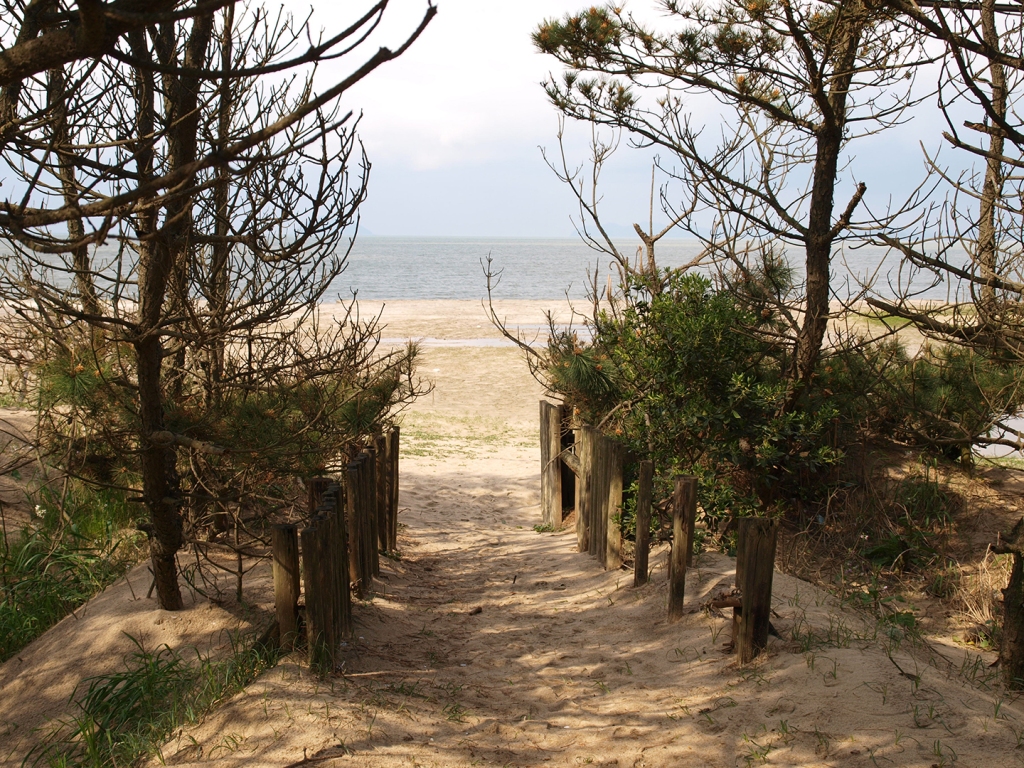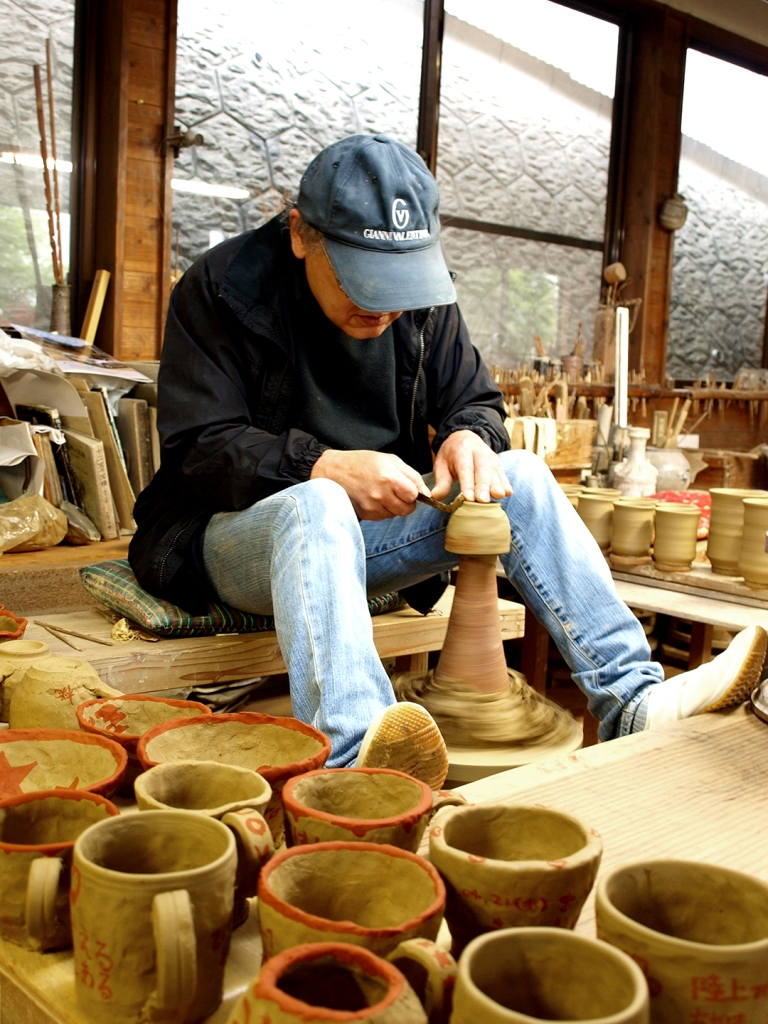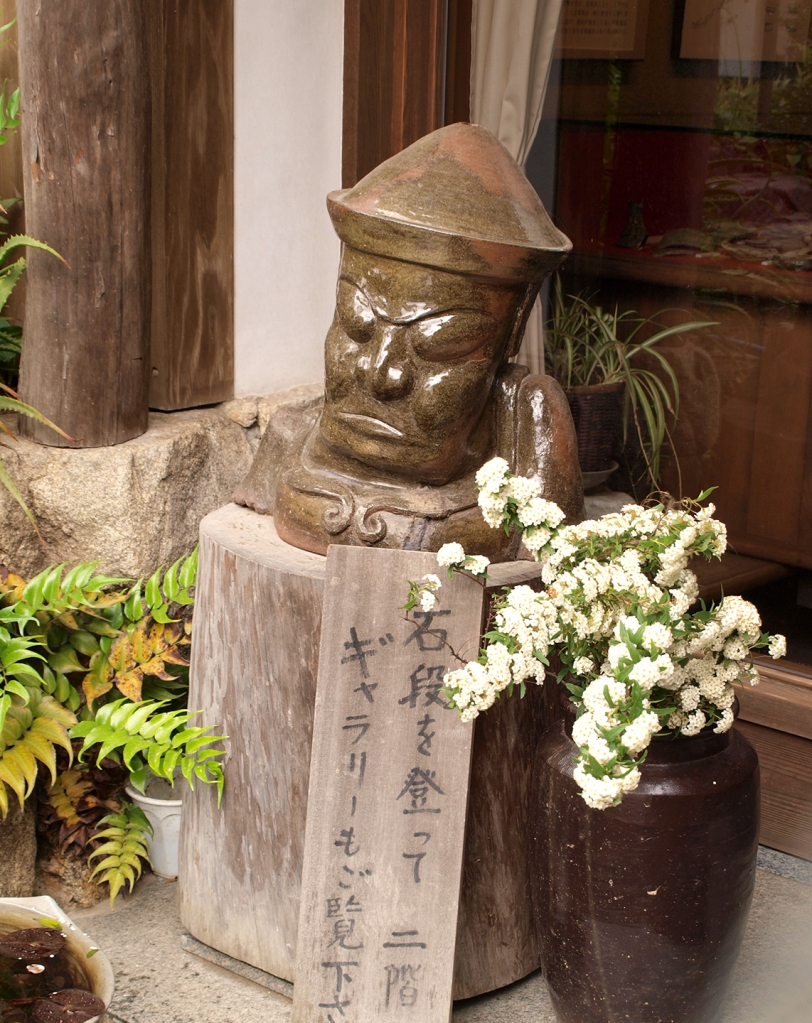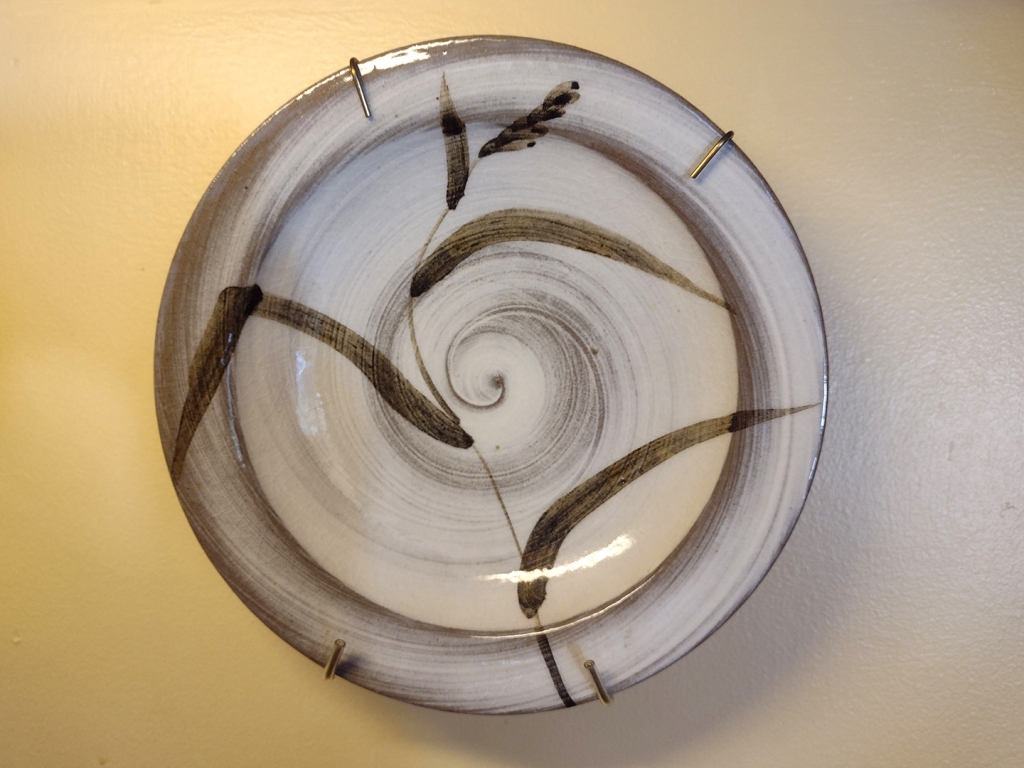I thought that the last stop on my potter’s pilgrimage, on the island of Kyushu, would be the most remote and provincial, but Karatsu, Japan is a thriving city, the women were fashionable, and it’s a bit of a resort town. Several school children called out “Hello, how are you?” giggling as they tried out some English; non-Asian foreigners were a rare sight. My hotel was on the Niji-no-Matsubara peninsula, right on the beach and surrounded by a dense, wind-blown, four-hundred-year-old pine forest, trunks twisting away from the sea. Rugged and churning, the Japan Sea tossed and turned the stormy afternoon I arrived, yet there was a windsurfer out there riding the waves.






Although the rates at my lodging weren’t those of a luxury hotel, the service was; I was treated like a visiting dignitary. Dinner at the hotel was among the best I’ve had in Japan. A table with a sea view had been reserved for me. After it grew dark, I could still see the white lines of the breakers rolling in to shore. Small, mouth-wateringly delicious dishes were elegantly presented on Karatsu-yaki. The sea bass sushi was garnished with a tiny sprig of Japanese maple leaves. A graceful young waiter described some highlights of the all-Japanese menu for me, using an English cheat sheet. He crouched on the floor next to my chair as he spoke, to show deference by looking up rather than looking down at the customer.
Learning of my interest in ceramics, the gracious hotel manager, M.-san, spoke with me, the two of us going back and forth between English and Japanese, about Karatsu-yaki and my travels to other pottery towns. At his urging, I brought my best purchases from the last two towns down from my room to show him. Delighted to touch and hold these small examples of Bizen and Hagi ware, he declared that I must visit a working pottery studio in his city. A good friend of his was a potter, but it would be difficult to get to his studio without a car, so he offered to take me in the morning.
We started with a drive up a nearby mountain to take in the view. As he drove, my impromptu tour guide noted that the trees were wearing their spring colors and that there were sixteen curves or switchbacks in the road.


Although his potter friend wasn’t in, his wife welcomed us. There were several people at work in the studio: two people trimming pots, one by hand and the other on a kickwheel, two others mixing clay, and one tending the area behind the kiln. Drying pots were spread along planks of wood and balanced high above on ceiling beams. Wooden tools, most handmade, were arranged along one wall. Large coarse paintbrushes were used in hakeme brushwork, a thick slip applied in circular motions, creating swirls of white glaze over a dark brown clay body.


We walked along the length of the hill kiln he had helped build as he described assisting his friend during firings, throwing in wood to fuel the blaze, keeping watch together on the progress of the firing. M.-san encouraged me to crawl into one of the low side openings and imagine how I would load pots into the kiln. I’m afraid that few of them would have survived the loading process!

After the studio, he left me at an exhibit hall, a showcase of local artists’ work, where he and a gallery employee mapped out some other places of interest for me to stop in town that afternoon on my own.
Around town








On this journey, I came to a greater understanding of the concept of wabi-sabi, a Japanese way of thinking. Wabi represents the appreciation and contemplation of beauty in the imperfect, the simple, the humble, and modest, a connection to nature. The sabi part refers to that which becomes more beautiful and flawed with age. It’s a philosophy that I would try to keep in mind after returning to the eastern metro area and wading back into the stressful work world.

An earlier pottery trip in Japan to Mashiko, home of Shoji Hamada: A Japanese treasure. Stops along this potter’s pilgrimage: Bizen, Hagi, and Hiroshima (not a pottery town, but a stop along the route).
Please do not download or reproduce images from this site. ©
Your comments are welcome!
Popular posts/stats/categories
Email me at: Ruth@RuthRosenfeld.com

How lucky you were to have a local tour guide! I was intrigued by the pieces next to the potter that was working on the wheel. They looked as if they were hand built and rather on the crude side for Japanese vessels. Do you know what those were?
LikeLiked by 1 person
We didn’t talk about them, but there was a potter there doing handbuilt pieces. (He didn’t want me to take a photo.) I also have pieces that were wheel-thrown and then altered.
LikeLiked by 1 person
You’ve certainly taken us to some off the beaten track spots in Japan. It’s great that you got a personalized tour. Love your plate. Maggie
LikeLiked by 1 person
Thanks, Maggie. This was an unexpected tour, maybe the best kind! Glad you appreciated the brushed plate.
LikeLiked by 1 person
What a wonderful trip, and beautiful scenery! Coincidentally I had dinner at a lovely restaurant last night called Wabi-Sabi. It’s great to know now what it means.
LikeLiked by 1 person
How nice! I’m guessing it was a Japanese or at least Asian restaurant.
LikeLiked by 1 person
It was a vegetarian Japanese resto. My new found favorite now as I loved their tantanmen
LikeLiked by 1 person
HiRuth,
I love the photo of you! Just beautiful. What a great adventure and how cool that you got to go to the potter’s studio.
LikeLiked by 2 people
Thanks, Michelle! The hotel man insisted on taking a photo – I usually prefer not to. It was certainly a special visit and tour.
LikeLiked by 2 people
Glad he did 😊
LikeLiked by 2 people
Wow, stunning! During my trip to Japan in 2016, I didn’t get to visit as many of the seaside towns as I would’ve liked (most of my trip was concentrated inland, in big cities like Tokyo, Kyoto, and Osaka). But being by the sea in Japan is a completely different experience from city life– very peaceful and world’s removed from the hustle and bustle culture. Looks like a calm stay in Karatsu!
LikeLiked by 1 person
That it was. An advantage of living in a place for a while is to get away from the tourist track, as interesting as it may be. My pottery interest led me to discover some places I wouldn’t have otherwise.
LikeLiked by 1 person
Very interesting to learn about this, thanks for sharing Ruth.
LikeLiked by 1 person
I’m glad you enjoyed this post, Rudi.
LikeLiked by 1 person
You accommodations were very accommodating.😊 How nice of the hotel manager to take you to a pottery shop and exhibition hall and make a list of other places to visit.
LikeLiked by 1 person
Yes, they were! It was a nice surprise to find someone interested in pottery and who enjoyed showing off his city and its arts.
LikeLike
What a great opportunity. On all of our trips to Japan, we found people to be very helpful. We were on Kyushu in 1985 at Kagoshima. At that point, few tourists went there, so it was quite immersive. Thanks for sharing. Allan
LikeLiked by 1 person
I didn’t make it quite that far, to Kagoshima. I’m sure it was a culturally interesting visit. Thanks, Allan.
LikeLiked by 1 person
All of the photos reveal an artistic quality of the subjects. The windblown forest, and the potter at work are two stand outs. The plate is amazing.
LikeLiked by 1 person
Thanks for your kind comment, Jay. I’m not at all surprised you found the plate as beautiful as I did. Your floral arrangements often grace ceramic vessels.
LikeLiked by 1 person
This sounds like a very special experience, thanks to your wonderful host. The courtesy that the Japanese extend to guests is something we could all learn from 🙂 I love your purchase and was very interested to read about the concept of wabi-sabi.
LikeLiked by 1 person
The personal tour was a unexpected and well appreciated ending to this week-long journey. Glad you enjoyed the post, Sarah!
LikeLiked by 1 person
You have such a way of describing your adventures that draws in the reader and makes me feel like I’m there. Thanks for sharing your journey and your photos with us.
LikeLiked by 1 person
Thank you,Carol! It’s about the writing for me, as much as the photos, and about the love of travel. I so appreciate your comment.
LikeLike
You know, Ruth, what’s extra fascinating about your posts is the sense of travel being lead by the pursuit of a specific interest. It’s taken you and is therefore taking us to different types of places and through different types of experiences, including different liaisons. I love reading these posts, they have real and unique qualities.
LikeLiked by 1 person
I once traveled for a while with a boyfriend who said “It’s more interesting when you have a mission.” Not all my travels fall into that category, but I do enjoy exploring a culture, art form, etc. Thanks so much for your thoughtful comment! I appreciate you.
LikeLiked by 1 person
Those tiles!! Beautiful images, especially the one of you. I collect pottery on my travels and every time I use a piece there is a memory.
LikeLiked by 1 person
I’d like to know more about your pottery! Thanks, Kerry. Those tiles really struck me as well.
LikeLiked by 1 person
I have 20 year old ceramic bowls from Lisbon (that I use everyday), endless stuff from Egypt with vivid coloring and a few muted items from Scotland. The tile shops in Mexico are heaven…
LikeLiked by 1 person
What a special experience Ruth, and lovely to see a photo of you 🙂
LikeLiked by 1 person
Thank you, Hannah! I don’t usually like to take pictures of me, but my hotelier/guide insisted. 😊
LikeLike
Those tools!!
LikeLiked by 1 person
You can see years of work on them, and lots of clay!
LikeLike
It sounds like you were saving the best for last on your potter’s pilgrimage. The island of Kyushu looks lovely and the people sound very hospitable. That was very kind of your hotel manager to take you to his friend’s pottery studio. Also, that’s a very nice picture of yourself.
LikeLiked by 1 person
Thanks, it did turn out the way – best for last. It was definitely worth the trek out to Kyushu. It completed the journey in a way I hadn’t expected.
LikeLiked by 1 person
Absolutely lovely descriptions of the hotel and the service. Nothing comes close to Japan, in my experience, when it comes to hospitality in cafes, restaurants and hotels. The hotel manager taking you to the pottery centre… just wonderful. This looks like such an authentic experience well away from the western tourist circuit. Thanks for bringing wabi-sabi to my attention, I was quite in the dark.
LikeLiked by 1 person
Thank you, Leighton. The hotelier and service were outstanding and quite unexpected. This town and its hospitality took me by surprise, and was truly an authentic experience. Glad to share my discovery of wabi-sabi, a philosophy so Japanese.
LikeLiked by 1 person
That he would take you to the village himself squares with all I’ve heard about the Japanese being wonderful people.
LikeLiked by 1 person
Yes, they are a kind and gentle people. He treated me as a special guest, and I think some of it was a bit of flirting. 😊 We had interesting conversation and learned from each other.
LikeLiked by 1 person
So many great pictures of the sea and beach … and it seems you really got lucky with your accommodation! I love the photo of the potter’s tools – so many! And that plate … it is really something special!
LikeLiked by 1 person
Thanks, this special stay more than made up for the creepy guy in Hagi. 😉 The plate is a treasured find from my years in Japan.
LikeLiked by 1 person
Beautiful trip of Karatsu ! So calm place ! You are looking beautiful! Thanks for sharing with excellent photos.👍
LikeLiked by 1 person
Thank you for your visit and kind comment!
LikeLike
It’s pleasure of mine stay blessed ❣️💕
LikeLike
Such a great trip, and beautiful scenery
PS You are gorgeous
LikeLiked by 1 person
Thanks so much, Luisa – so kind of you!
LikeLiked by 1 person
❣️❣️❣️
LikeLike
I love the seamless transition from the general (the tour of Karatsu) to the specific (the pottery). Both give this post such appeal. The description of your dining experience and wabi-sabi will stick with me.
LikeLiked by 1 person
Thanks, Dave, it was certainly a memorable trip in so many ways. The dining and wabi-sabi philosophy has stayed with me as well.
LikeLike
It’s such a lovely post! I was in Karatsu last month, but I didn’t know it was an important city for pottery. I plan to go back in November for its famous festival, so I hope to check out its pottery!
LikeLiked by 1 person
Thanks so much for your visit and comment. It would be great to be there for the festival. Enjoy!
LikeLiked by 1 person